
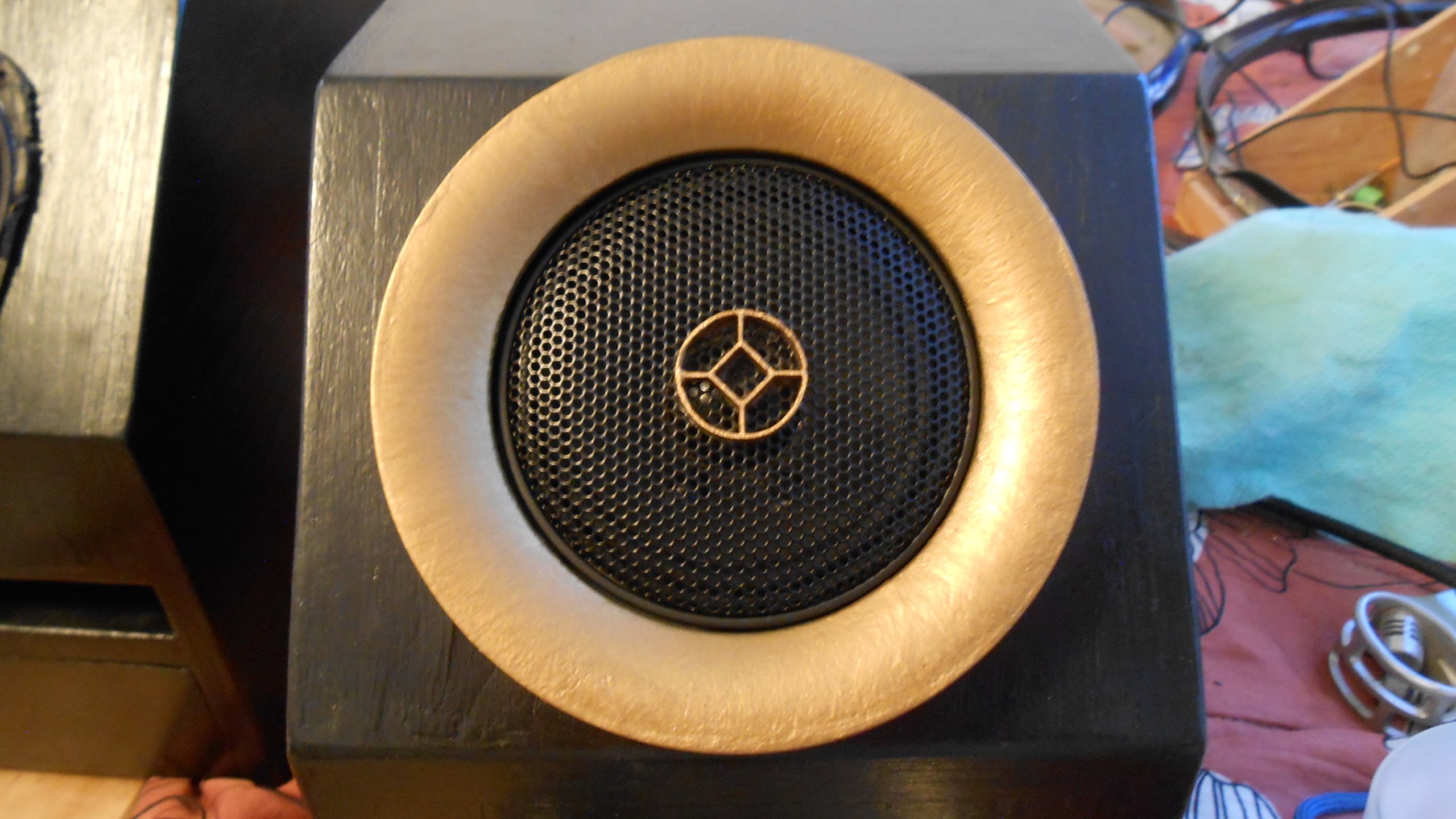
~15 W/channel.
Crossoverless design roughly equivalent to 25-30W of power for two-way speakers.
3.5 mm and RCA line inputs.
Fullrange hi-fi 3.3" drivers.
Class AB built-in amplifier assembled with Nichicon audio-grade (gold) electrolytic, Panasonic polypropylene capacitors and mil-spec silver-plated wiring.
Unstable design (like a musical instrument) with wooden enclosures and wooden legs (highly expressive and musical/natural sound).
Say Something...
- Details
- Written by Admin
- Category: Blog
- Hits: 25
This is still a bit of a secret, but here they are.
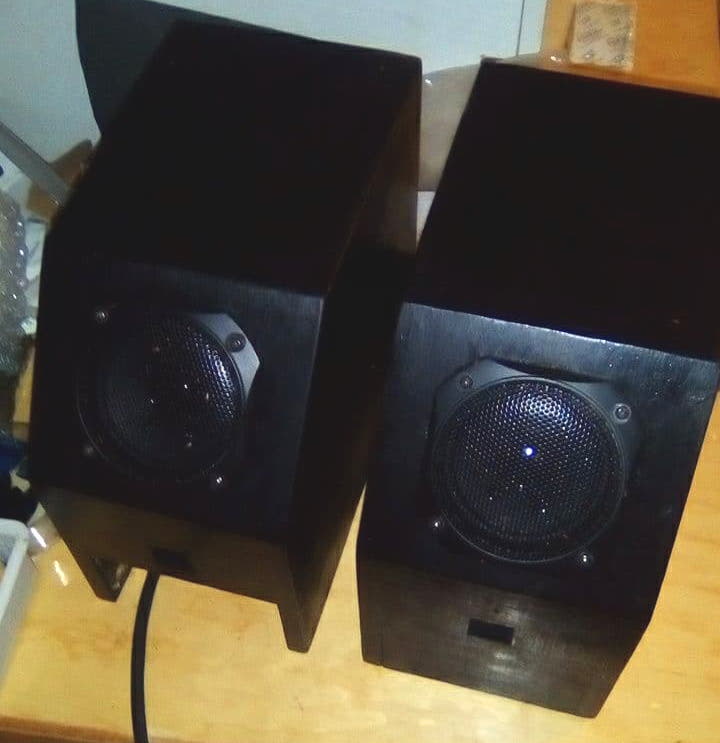
Small 30-W fullrange speakers. 7.5 cm. hi-fi drivers, crossoverless, embedded LM3886 Gainclone amplifier.
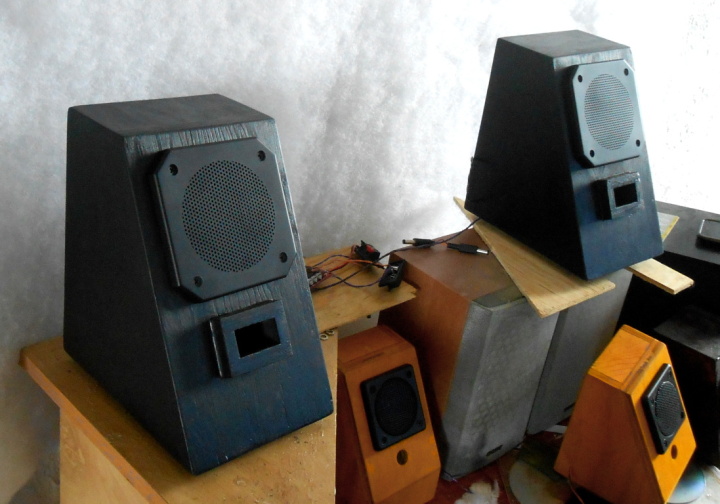
MP-15 final prototype (version 4.5), 55-22000 Hz frequency response, 9.5 cm. hi-fi fullrange drivers crossoverless,
simple preamp, LM1876 class AB amplifier (~15W).
The small speakers below the MP-15 are another prototype which was not that successful (they need better drivers).
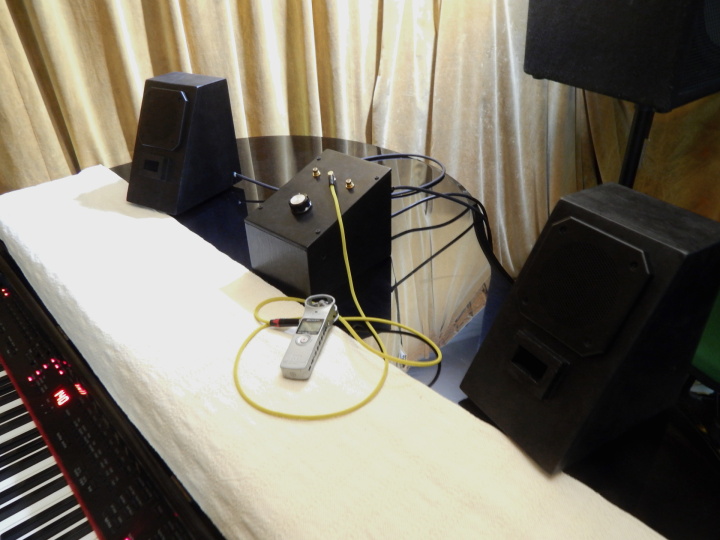
Assembled with amplifier and line cable.
Class D amplifiers were also considered.
- Details
- Written by Admin
- Category: Blog
- Hits: 221
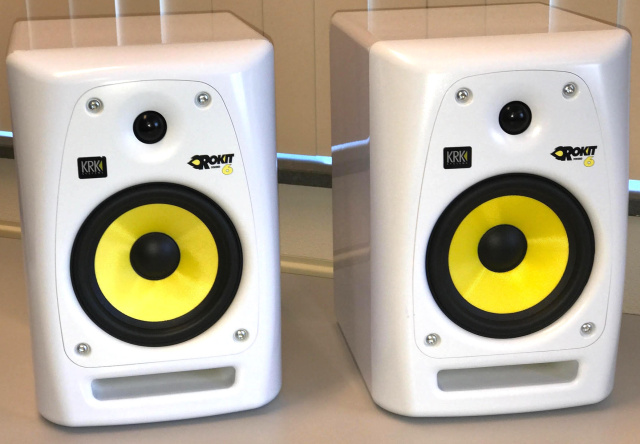
In short, it's two things: Lack of treble definition and too much power. The speakers are biamplified, and the tweeter amps have a lower dynamic range than the midrange amps. This is a cheap trick to make folks mix more in the midrange, and insure there's treble sparkle in mixes when played on other speakers. That works for a while, but later on the lack of treble resolution and too much power make mixes skewed towards midrange, bass and power at the expense of space definition and sweetness and just straight balance.
They also have crummy RCA inputs to pretend the balanced inputs are so much better or something like that. That is somewhat beside the point though as RCA inputs weren't used. In a nutshell, they're good for making shouty, bassy mixes with a smiley EQ, not much else. 65-dB dynamic range for treble/midrange (crossover's at 1600 Hz) is flat. Now of course this will sound "better" with 44-KHz mixes as 44-KHz PCM is flat with ugly undefined treble, but then anything above that lacks the treble and spatial definition and instrument separation there ought to be.
So in response to all this trouble, new speakers have been made. They're based on a German hi-fi driver design. Which is fullrange, thus avoiding any crossover distortion/size problem (to make a crossover sound good, it ought to have big and heavy thick-wire aircore inductors). They're small (the drivers are 3.3" or 8 cm. diameter). Maximum input power is 30 W/channel with 50 W peaks. Unlike commercial speakers, these are made of spruce plywood. This has the advantage of musicality: Spruce resonates and is consonant with musical instruments, so strings sound like strings, not screechiness as on overdampened MDF speakers. Drums are also very lifelike, thanks to the small drivers' quick transients and spruce resonance. The speakers play music more like music, with expression and character mass-produced speakers never achieve.

This is a phone photo, there might be better camera shots later.
- Details
- Written by Admin
- Category: Blog
- Hits: 1356

Hexen Hall.mid.
Hexen Hub.mid.
Hexen Grover.mid. This is roughly the same as the old mix, but now with the correct acoustic bass.
These three all have the new Direct Bass playing the acoustic bass parts.
Hexen Voidr.mid. Background strings are now more noticeable. All small percussion is original Solar
Samples, also cymbals.
Heretic Mus_E2M1.mid - the Crater map soundtrack.
Heretic Mus_E2M2.mid - the Lava Pits map soundtrack.
New Heretic sounds:
Secret sound for ZDoom/derivatives:
Wrath of Cronos levelup:
Wrath of Cronos coin sound (used by the store and as pickup):
Wrath of Cronos merchant "no" (out of items):
Wrath of Cronos low magicka:
Heretic Soundtrack 2 now has its own page with drafts of mixes for soundtrack version 2.
There's also a couple Age of Empires II mixes ("Shamburger" and "Hyman's Wrath", that last one used
in a Hexen II map by Whirledtsar, "Shifting Sands"). They now have a dedicated page of their own.
- Details
- Written by Admin
- Category: Blog
- Hits: 1734
There are lots of comments to the tune of "wood doesn't affect an electric guitar's tone, only strings do".
That is utterly daft. Daft beyond words. Cretin.
A maple-neck Stratocaster sounds very different to an all-mahogany SG, as an example. Why? Not just because of the scale and electronics and so on. Also because of different woods.
The "rationale" behind the mad statement above is that electromagnetic pickups only sense steel strings, not the wood.
But, the strings' sound already includes the wooden tone. It's as simple as that; the only way strings won't have the tone of their underlying platform is if the guitar's built out of a stone or concrete wall (no wooden parts whatsoever). Even then there might be some stone or concrete overtones.
The vibration of strings' underlying surface (a slab of wood in the case of a solid electric guitar) is added to the metal tone of strings. The wood's resonant character affects strings just the same as it affects a drumhead. The physics are simple - strings (or drumheads) fire into the wood, the soundwave goes through the wood and is bounced back into the strings with the wood's resonant pattern and added (or subtracted) energy. As an example, basswood has next to no resonance except a boomy bass response (basswood drums are famous for being awful to mix because of that), mahogany has a "toasty" darkish tone with strong lower midrange when in an overdriven guitar, it is also used for thunderous, warmish drums; maple has a fairly high primary resonance frequency and so is great for recording in either drums or guitars (maple guitar necks are by far the cleanest-sounding). Ash (a favourite of Leo Fender) subtracts itself from a guitar's tone when used as a body anchor with a maple neck, hence the thinner, clear tone of higher-end Stratocasters.
A guitar with no wood (or other resonant material), just the strings set in a stone or lead or glass base, would be very dull. A glass guitar, as an example, would be utterly dead-sounding as thick glass absorbs sound instead of firing it back into strings. As an experiment, tape a glass ashtray to an electric guitar and hear the change in its character. It'll go dullish. All a fixed or sound-absorbing guitar might produce will be a rather hushed-up, dead string sound with next to no life and sparkle, no warm, thick body as that of a regular wooden guitar.
- Details
- Written by Admin
- Category: Blog
- Hits: 2302
An all-mahogany SG played by Pablo. The guitar features John Birch Hiflux pickups (18000-N/16000-B closed humbuckers). This is also the guitar that plays in the Heretic E1M7 mix. This is just the guitar played through Marshall Jackhammer 2 overdrive (gain and tone at 12 o'clock) into the amp's reverb. The strings are La Bella HRS-75, so it's almost Black Sabbath tone.
- Details
- Written by Admin
- Category: Blog
- Hits: 2253
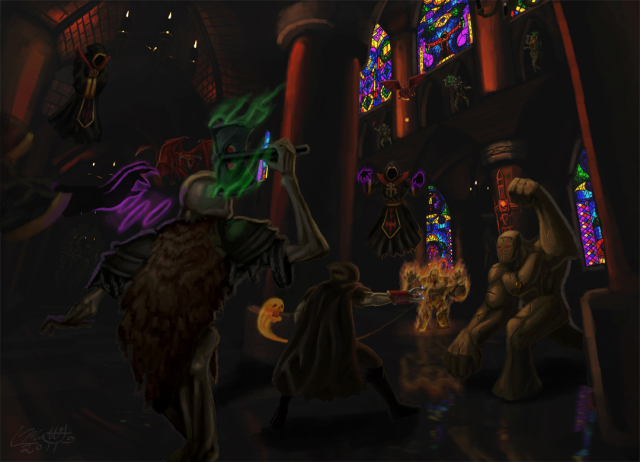
This is often requested. This is a beta mix, part of Heretic Soundtrack 2. Image: Liamythesh.
- Details
- Written by Admin
- Category: Blog
- Hits: 3075
It's that classic single-coil pickup. Not really Stratocaster; stiffer and more powerful.
- Details
- Written by Admin
- Category: Blog
- Hits: 3428
Miller capacitance of transistor amplifiers is about 10-15 times that of valve amplifiers at higher frequencies. Simply put, Miller capacitance is the lag between line input and amp output. Transistors, therefore, lag in treble and even high midrange, compared to valves. Wonder why guitar players prefer valve amps? They've better contour and presence. Transistor amps are more neurotic/inaccurate in treble.
Copper has higher capacitance at higher frequencies than silver. Even though it is not by as much, it adds up to the rest of lag to make a serious difference in dynamics. Wonder why silver wiring is better? There's why.
Different types of capacitors have different sonic transparency. Again, this is because of lag at higher frequencies. Polypropylene, teflon, and silver mica are the most audio-friendly. Capacitors, especially electrolytic, can also have lag in high frequencies due to increasing resistance: this distortion type is called ESR - equivalent series resistance. Cheap electrolytics are the worst in terms of ESR - some are so bad, they audibly lowpass at 3 KHz.
Overall, the audio electronic engineers' fixation with numbers and frequency response is something of a bugger, if only because they forget about dynamics and accuracy in the time domain. A playback device is so much better when it responds quickly - even if in measured terms a treble delay introduced by combined HF lag of transistors, copper, and barmy capacitors and resistors might be something like 1-4 msec., it's usually enough to make or break liveliness and realism.
- Details
- Written by Admin
- Category: Blog
- Hits: 5683
It's negative chorus+delay:
- Details
- Written by Admin
- Category: Blog
- Hits: 6647
Truth be told, there're better dynamic microphones for recording guitar amps, even in the same price range. Still, if you're stuck with an SM57, there's a simple workaround for its trebley boost, which can often highlight the fogginess and harshness of a guitar and transistor effects/amplifier. The workaround is simply applying a compensation EQ - an EQ curve designed to neutralise the SM57's frequency response. Better still, Spline EQ is an equaliser plugin which allows controlling overall EQ gain range. Halving the SM57 frequency response by dialling 0.5 Spline EQ gain scale is usually better than leaving it dry, that makes the guitar play more solid. Spline EQ even allows negatives, so instead of neutralising SM57 response fully, an SM57 frequency response can be simulated (but not its transformer dynamics though) when needed: it does help to bring a guitar up a in a mix sometimes.
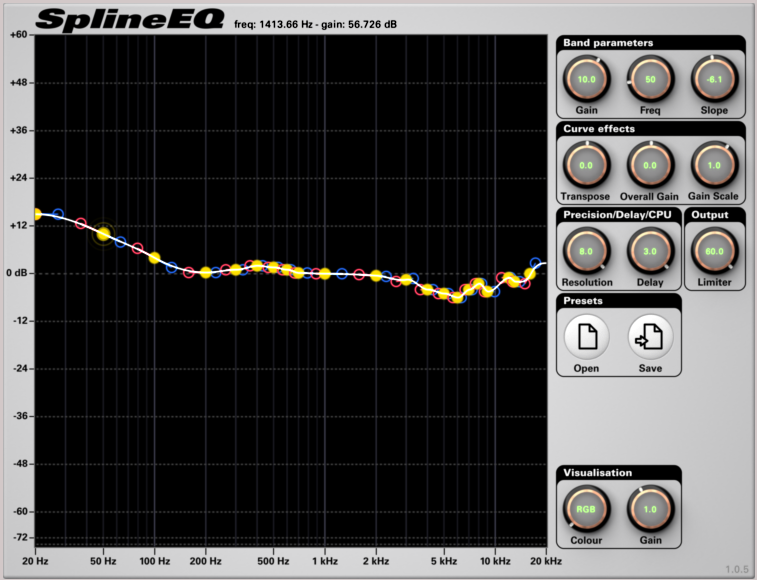
- Details
- Written by Admin
- Category: Blog
- Hits: 11665
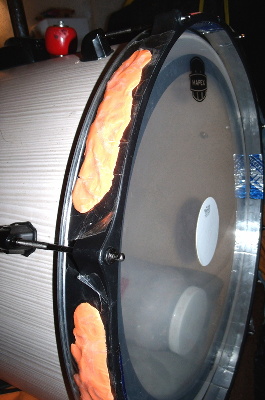
- Details
- Written by Admin
- Category: Blog
- Hits: 11824
Material also affects string damping, a heavy guitar will produce a tone that's more pure string rather than a light guitar, which will tend to produce a lighter, less focused string tone. Metal instruments are actually the ones that mix best (triangle and cymbals are an example). The harder it is for a given material to vibrate, and the better it absorbs vibration, the more focused the tone will be. This also lends itself to damping experiments with materials like Dynamat and Blu-tack and just plain old plastiline. Material can be anything too, there're some glassfibre guitars and drums out there.
- Details
- Written by Admin
- Category: Blog
- Hits: 1359

 Arpeggiator
Arpeggiator